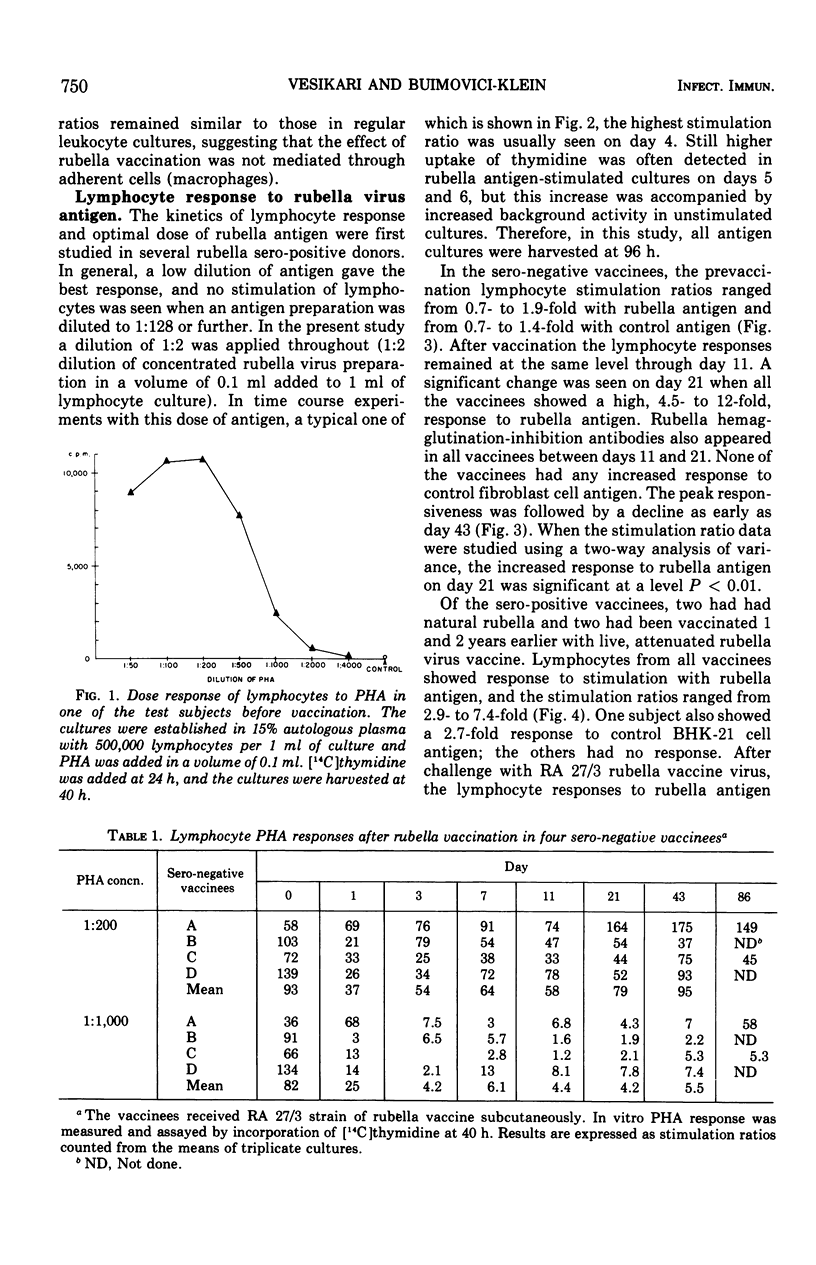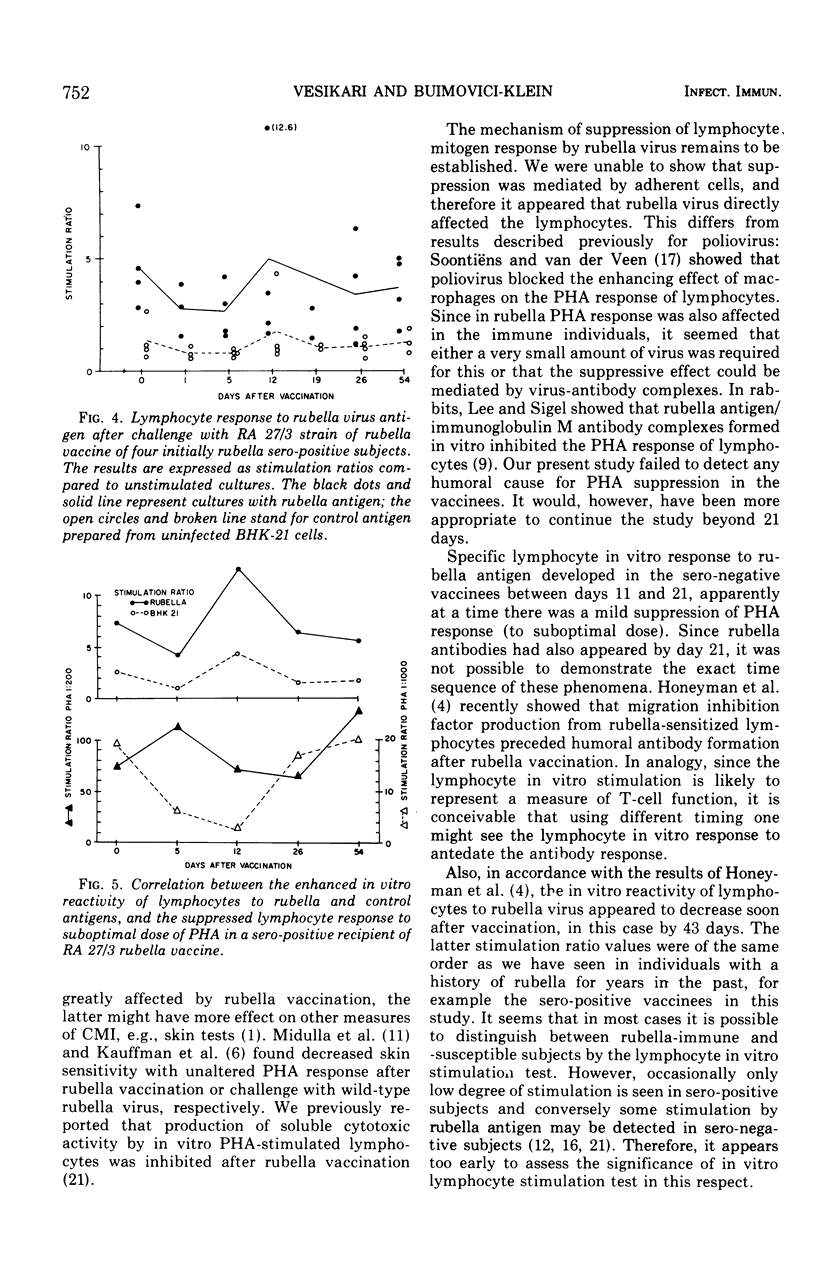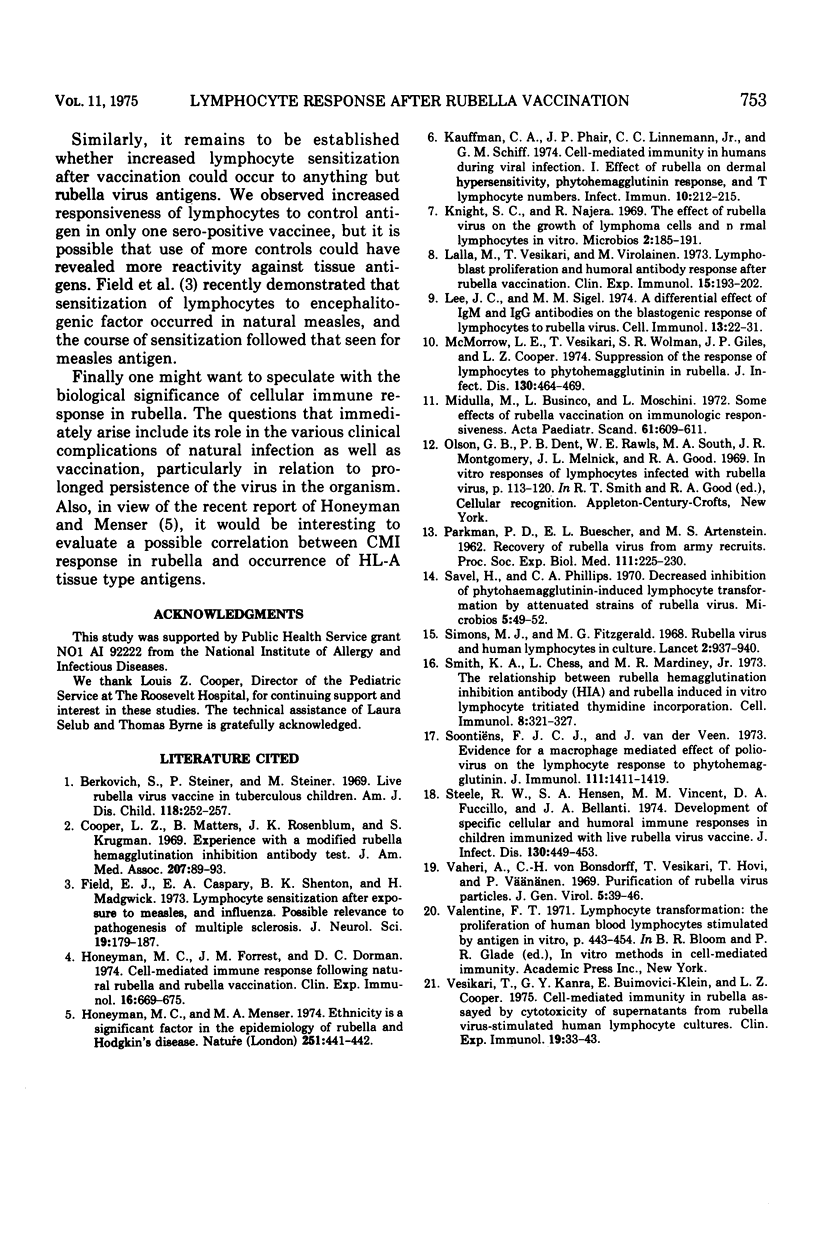Abstract
Lymphocyte phytohemagglutinin (PHA) responsiveness was found suppressed in both rubella sero-negative and sero-positive recipients of RA 27/3 strain of live attenuated rubella vaccine; the suppression was readily demonstrable only when a suboptimal dose of PHA was applied in the test. Lymphocytes from sero-negative vaccinees, which initially showed little or no in vitro response to concentrated rubella virus, became responsive after vaccination by day 21, when the highest sensitization to rubella antigen was seen. In the sero-positive vaccinees. lymphocytes responded to rubella antigen in vitro before vaccination, and in most cases vaccination did not result in significant changes in lymphocyte response. These results suggest that rubella vaccination leads to temporarily increased lymphocyte reactivity to rubella antigen, and the increased lymphocyte response to specific antigen may occur at the time of mild suppression of PHA response.
Full text
PDF





Selected References
These references are in PubMed. This may not be the complete list of references from this article.
- Berkovich S., Steiner P., Steiner M. Live rubella virus vaccine in tuberculous children. Am J Dis Child. 1969 Aug;118(2):252–257. [PubMed] [Google Scholar]
- Cooper L. Z., Matters B., Rosenblum J. K., Krugman S. Experience with a modified rubella hemagglutination inhibition antibody test. JAMA. 1969 Jan 6;207(1):89–93. [PubMed] [Google Scholar]
- Field E. J., Caspary E. A., Shenton B. K., Madgwick H. Lymphocyte sensitization after exposure to measles, and influenza. Possible relevance to pathogenesis of multiple sclerosis. J Neurol Sci. 1973 Jun;19(2):179–187. doi: 10.1016/0022-510x(73)90161-5. [DOI] [PubMed] [Google Scholar]
- Honeyman M. C., Menser M. A. Ethnicity is a significant factor in the epidemiology of rubella and Hodgkin's disease. Nature. 1974 Oct 4;251(5474):441–442. doi: 10.1038/251441a0. [DOI] [PubMed] [Google Scholar]
- Kauffman C. A., Phair J. P., Linnemann C. C., Jr, Schiff G. M. Cell-mediated immunity in humans during viral infection. I. Effect of rubella on dermal hypersensitivity, phytohemagglutinin response, and T lymphocyte numbers. Infect Immun. 1974 Jul;10(1):212–215. doi: 10.1128/iai.10.1.212-215.1974. [DOI] [PMC free article] [PubMed] [Google Scholar]
- Lalla M., Vesikari T., Virolainen M. Lymphoblast proliferation and humoral antibody response after rubella vaccination. Clin Exp Immunol. 1973 Oct;15(2):193–202. [PMC free article] [PubMed] [Google Scholar]
- Lee J. C., Sigel M. M. A differential effect of IgM and IgG antibodies on the blastogenic response of lymphocytes to rubella virus. Cell Immunol. 1974 Jul;13(1):22–31. doi: 10.1016/0008-8749(74)90223-8. [DOI] [PubMed] [Google Scholar]
- McMorrow L. E., Vesikari T., Wolman S. R., Giles J. P., Cooper L. Z. Suppression of the response of lymphocytes to phytohemagglutinin in rubella. J Infect Dis. 1974 Nov;130(5):464–469. doi: 10.1093/infdis/130.5.464. [DOI] [PubMed] [Google Scholar]
- Midulla M., Businco L., Moschini L. Some effects of rubella vaccination of immunologic responsiveness. Acta Paediatr Scand. 1972 Sep;61(5):609–611. doi: 10.1111/j.1651-2227.1972.tb15954.x. [DOI] [PubMed] [Google Scholar]
- PARKMAN P. D., BUESCHER E. L., ARTENSTEIN M. S. Recovery of rubella virus from army recruits. Proc Soc Exp Biol Med. 1962 Oct;111:225–230. doi: 10.3181/00379727-111-27750. [DOI] [PubMed] [Google Scholar]
- Simons M. J., Fitzgerald M. G. Rubella virus and human lymphocytes in culture. Lancet. 1968 Nov 2;2(7575):937–940. doi: 10.1016/s0140-6736(68)91167-7. [DOI] [PubMed] [Google Scholar]
- Smith K. A., Chess L., Mardiney M. R., Jr The relationship between rubella hemagglutination inhibition antibody (HIA) and rubella induced in vitro lymphocyte tritiated thymidine incorporation. Cell Immunol. 1973 Aug;8(2):321–327. doi: 10.1016/0008-8749(73)90121-4. [DOI] [PubMed] [Google Scholar]
- Soontiëns F. J., van der Veen J. Evidence for a macrophage-mediated effect of poliovirus on the lymphocyte response to phytohemagglutinin. J Immunol. 1973 Nov;111(5):1411–1419. [PubMed] [Google Scholar]
- Steele R. W., Hensen S. A., Vincent M. M., Fuccillo D. A., Bellanti J. A. Development of specific cellular and humoral immune responses in children immunized with live rubella virus vaccine. J Infect Dis. 1974 Nov;130(5):449–453. doi: 10.1093/infdis/130.5.449. [DOI] [PubMed] [Google Scholar]
- Vaheri A., von Bonsdorff C. H., Vesikari T., Hovi T., Vänänen P. Purification of rubella virus particles. J Gen Virol. 1969 Jul;5(1):39–46. doi: 10.1099/0022-1317-5-1-39. [DOI] [PubMed] [Google Scholar]
- Vesikari T., Kanra G. Y., Buimovici-Klein E., Cooper L. Z. Cell-mediated immunity in rubella assayed by cytotoxicity of supernatants from rubella virus-stimulated human lymphocyte cultures. Clin Exp Immunol. 1975 Jan;19(1):33–43. [PMC free article] [PubMed] [Google Scholar]


